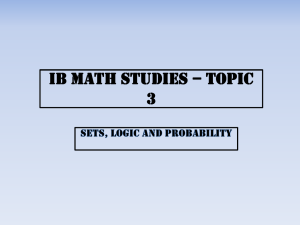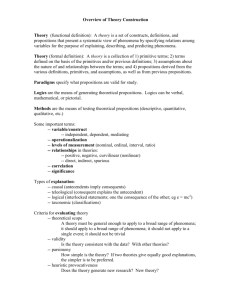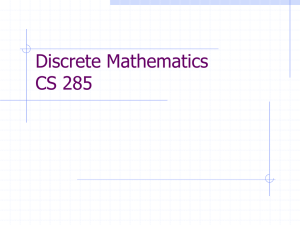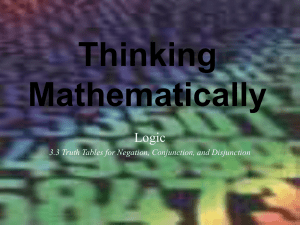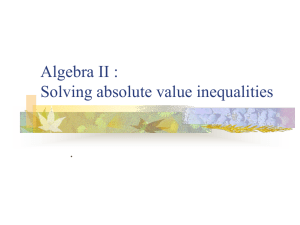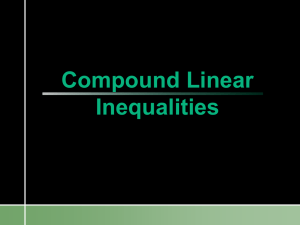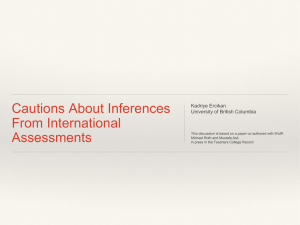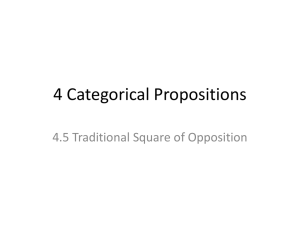p - baiermathstudies
advertisement
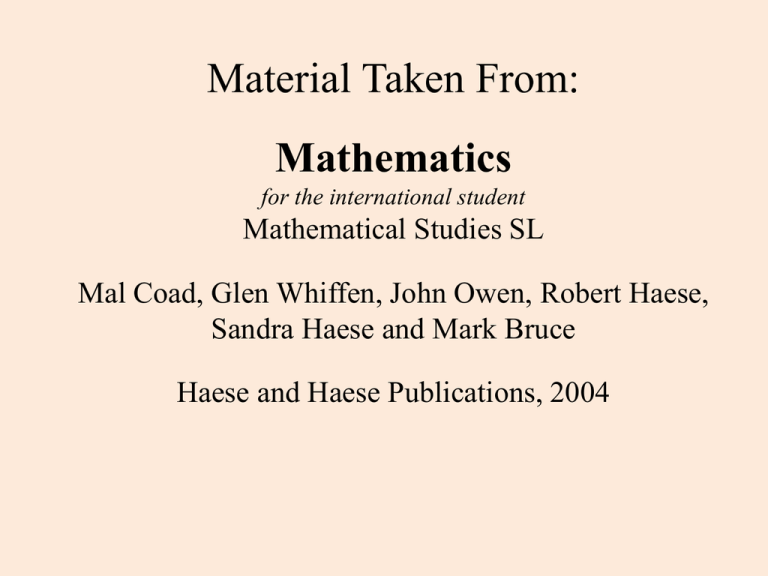
Material Taken From:
Mathematics
for the international student
Mathematical Studies SL
Mal Coad, Glen Whiffen, John Owen, Robert Haese,
Sandra Haese and Mark Bruce
Haese and Haese Publications, 2004
Chapter 15A - Propositions
Mathematical Logic
Converting worded statements into symbols,
then applying rules of deduction.
Example of deductive reasoning:
•All teachers are poor.
•I am a teacher.
•By using logic, it follows that I am poor.
• Logic, unlike natural language, is precise and exact.
• Logic is useful in computers and artificial intelligence
where there is a need to represent the problems we
wish to solve using symbolic language.
BrainPop – Binary Video
For each of these statements, list the students for which the
statement is true:
a) I am wearing a green shirt.
b) I am not wearing a green shirt
c) I am wearing a green shirt and green pants.
d) I am wearing a green shirt or green pants.
e) I am wearing a green shirt or green pants, but not both.
Propositions
Statements which may be true or false.
• Page 496 in the text.
• Questions are not propositions.
• Comments or opinions are not propositions.
• Example: ‘Green is a nice color’ is subjective; it is not
definitely true or false.
• Propositions may be indeterminate.
• Example: ‘your father is 177 cm tall’ would not have the same
answer (true or false) for all people.
• The truth value of a proposition is whether it is true or false.
Example 1
Which of the following statements are propositions?
If they are propositions, are they true, false, or indeterminate?
a)
b)
c)
d)
20 4 = 80
25 × 8 = 200
Where is my pen?
Your eyes are blue.
Notation
• We represent propositions by letters such as p, q and r.
• For example:
– p: It always rains on Tuesdays.
– q: 37 + 9 = 46
– r: x is an even number.
Negation
• The negation of a proposition p is “not p” and is written
as ¬p.
• The truth value of ¬p is the opposite of the truth value of
p.
• For example:
p: It is Monday.
¬p: It is not Monday.
q: Tim has brown hair.
¬q: Tim does not have brown hair.
Truth Tables
• Using the example:
– p: It is Monday.
– ¬p: It is not Monday.
p
T
F
¬p
F
T
¬(¬p)
T
F
Example 2
Find the negation of:
a)
x is a dog for x {dogs, cats}
b)
x ≥ 2 for x N
c)
x ≥ 2 for x Z
Section 15B - Compound Propositions
Compound propositions
Statements which are formed using ‘and’ or ‘or.’
• ‘and’ conjunction
– notation: p q
• ‘or’ disjunction
– notation: p q
Conjunction vs. Disjunction Examples
Conjunction
p: Eli had soup for lunch
q: Eli had a pie for lunch.
p q:
Disjunction
p: Frank played tennis today
q: Frank played golf today.
p q:
• p q is true if one or both
propositions are true.
• p q is only true if both
original propositions are true. • p q is false only if both
propositions are false.
Conjunction/Disjunction and Truth
Tables
p
T
T
F
F
q
T
F
T
F
pq pq
T
T
F
T
F
T
F
F
Conjunction/Disjunction and Venn Diagrams
Suppose P is the truth set of p, and Q is the truth set of q.
PQ
P
Q
the truth set for pq is PQ
the truth set for pq is PQ
U
PQ
Examples 3 and 4
Write p q for the
following :
p: Kim has brown hair,
q: Kim has blue eyes
Determine whether p q
is true or false:
p: A square has four sides,
q: A triangle has five sides
Examples 5 and 6
Write the disjunction p q for
p: x is a multiple of 2,
q: x is a multiple of 5.
Determine whether p q
is true or false
p: There are 100 in a right
angle,
q: There are 180 on a
straight line.
Exclusive Disjunction
Is true when only one of the propositions is true.
• notation: p q
•
p q means “p or q, but not both”
• For example,
– p: Sally ate cereal for breakfast
– q: Sally ate toast for breakfast
pq
p
T
T
F
F
q
T
F
T
F
pq
F
T
T
F
Exclusive Disjunction
pq
• In Logic ‘or’ is usually given in the inclusive sense.
– “p or q or both”
• If the exclusive disjunction is meant, then it’ll be stated.
– “p or q, but not both’ or “exactly one of p or q”
Example 7
Write the exclusive disjunction
pq
p: Ann will invite Kate to her party,
q: Ann will invite Tracy to her party.
for
Examples 8 and 9
Consider r: Kelly is a good driver, and s: Kelly has a good car.
• Write in symbolic form:
a) Kelly is a good driver and has a good car.
b) Kelly is not a good driver or has a good car.
Consider x: Sergio would like to go swimming tomorrow, and y:
Sergio would like to go bowling tomorrow
• Write in symbolic form:
– Sergio would not like to go both swimming and bowling
tomorrow.
Example 10
Define appropriate propositions and then
write in symbolic form:
– Phillip likes ice cream or Phillip does not like Jell-O –
Homework (from 2nd edition)
• 17A.1 (every other problem)
• #1, #2, #4, #5
• 17B.1 (every other problem)
• #1, #2
• 17B.2
• #1ac, #2ad, #3a, #6ace, #7aeg, #11
